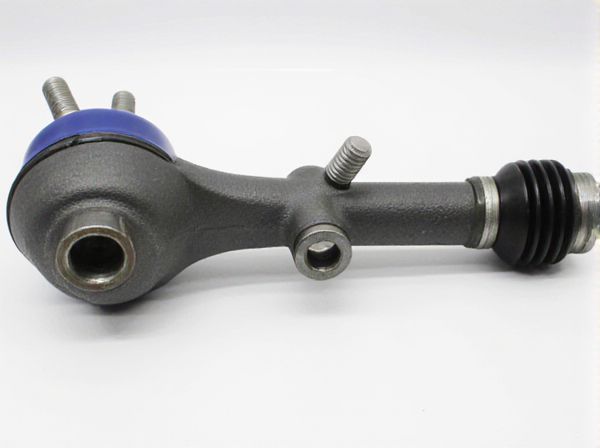
Photo illustration: Integral Type Steering Box vs Linkage Type Steering Box
Integral Type Steering Box offers a compact design with fewer moving parts, resulting in enhanced durability and smoother steering response. Linkage Type Steering Box relies on external linkages for movement, which can increase complexity and maintenance but provides easier customization for specific vehicle setups. Choosing the right steering box depends on your vehicle's design requirements and desired steering precision.
Table of Comparison
| Feature | Integral Type Steering Box | Linkage Type Steering Box |
|---|---|---|
| Design | Single unit combining steering gears and linkages | Separate steering gears connected by linkages |
| Complexity | Compact, less complex | More components, higher complexity |
| Maintenance | Lower maintenance due to fewer parts | Higher maintenance, multiple linkage points |
| Durability | Generally more durable and robust | Subject to wear in linkages |
| Steering Precision | Better precision and responsiveness | Less precise due to multiple joints |
| Application | Common in heavy-duty vehicles | Used in light vehicles and trucks |
| Cost | Higher initial cost | Lower cost |
Introduction to Steering Box Types
Integral type steering boxes feature a compact, all-in-one design where the worm gear and sector gear are housed within a single unit, offering enhanced durability and reduced maintenance. Linkage type steering boxes utilize external mechanical linkages to connect the steering gear components, providing simpler construction but potentially increased play and wear over time. Choosing between these types impacts steering responsiveness, system complexity, and maintenance requirements in automotive and heavy machinery applications.
Overview of Integral Type Steering Box
Integral Type Steering Box features a compact design where the worm gear and sector gear are enclosed within a single housing, enhancing durability and reducing maintenance needs. This type offers improved steering precision by minimizing play between components compared to Linkage Type Steering Boxes, which use external linkages prone to wear. Commonly used in heavy-duty vehicles, the Integral Type Steering Box supports higher torque loads and delivers more reliable steering performance.
Overview of Linkage Type Steering Box
Linkage type steering boxes utilize a series of mechanical linkages to transfer motion from the steering wheel to the wheels, offering simpler construction and easier maintenance compared to integral type steering boxes. This system often features components like pitman arms, idler arms, and center links to convert rotational input into linear motion. The design is commonly favored in older or heavy-duty vehicles due to its robustness and ability to handle high steering loads.
Key Components of Integral Steering Systems
Integral type steering boxes incorporate the steering gear and linkage assembly within a single housing, enhancing alignment precision and reducing mechanical play. Key components include the worm gear, sector shaft, and internal linkage, which work cohesively to translate steering wheel input into wheel movement with reduced backlash. In contrast, linkage type steering boxes separate the gear mechanism from the external linkages, often resulting in increased maintenance due to exposed joints and potential misalignment.
Key Components of Linkage Steering Systems
Linkage type steering boxes consist of key components such as pitman arms, idler arms, center links, and tie rods, which work together to translate the steering wheel's rotation into lateral movement of the wheels. These components create a mechanical linkage system that provides direct steering response and ease of repair compared to integral type steering boxes. In contrast, integral type steering boxes combine steering gear and linkage within a single unit, offering compactness but less modularity than linkage type systems.
Performance Comparison: Integral vs Linkage
The Integral Type Steering Box offers superior precision and durability due to its enclosed design, reducing play and enhancing steering responsiveness compared to the Linkage Type Steering Box. Linkage Type Steering Boxes tend to exhibit greater mechanical wear and increased free play over time, which negatively impacts steering accuracy and performance. Consequently, vehicles equipped with Integral Steering Boxes benefit from more consistent handling and improved road feedback under demanding driving conditions.
Durability and Maintenance Factors
Integral type steering boxes feature a robust, single-unit construction that enhances durability by reducing wear points and minimizing exposure to contaminants, leading to longer service life and fewer maintenance requirements. Linkage type steering boxes, composed of multiple connected parts, are more prone to wear and require frequent inspections and adjustments to maintain optimal performance. Maintenance for integral types tends to be simpler and less frequent, whereas linkage types demand regular lubrication and part replacements to ensure reliability.
Application Suitability in Modern Vehicles
Integral type steering boxes provide precise control and are best suited for heavy-duty vehicles such as trucks and off-road equipment that require robust performance and durability. Linkage type steering boxes, known for their simplicity and lighter weight, are more appropriate for smaller passenger cars and light-duty vehicles where compact design and cost-efficiency are priorities. Modern vehicles prioritize integral type steering for enhanced feedback and reliability in demanding conditions, while linkage types remain popular in economical and compact models due to ease of maintenance and manufacturing.
Common Issues and Troubleshooting
Integral type steering boxes often face problems such as internal gear wear, oil leakage, and stiff steering due to sealed housing design, requiring inspection of lubricants and seals for troubleshooting. Linkage type steering boxes commonly exhibit issues like loose or worn tie rods, misalignment, and linkage play, which can be addressed by adjusting or replacing worn components and realigning the steering system. Regular maintenance and prompt identification of symptom patterns in both types help prevent steering failure and improve vehicle handling performance.
Conclusion: Choosing the Right Steering Box
Choosing the right steering box depends on application-specific requirements such as steering precision, maintenance needs, and vehicle type. Integral type steering boxes offer compact design and durability, ideal for heavy-duty or off-road vehicles requiring robust performance. Linkage type steering boxes provide simpler construction and easier maintenance, suitable for lighter vehicles where cost-effectiveness and straightforward mechanics are prioritized.
 caratoz.com
caratoz.com